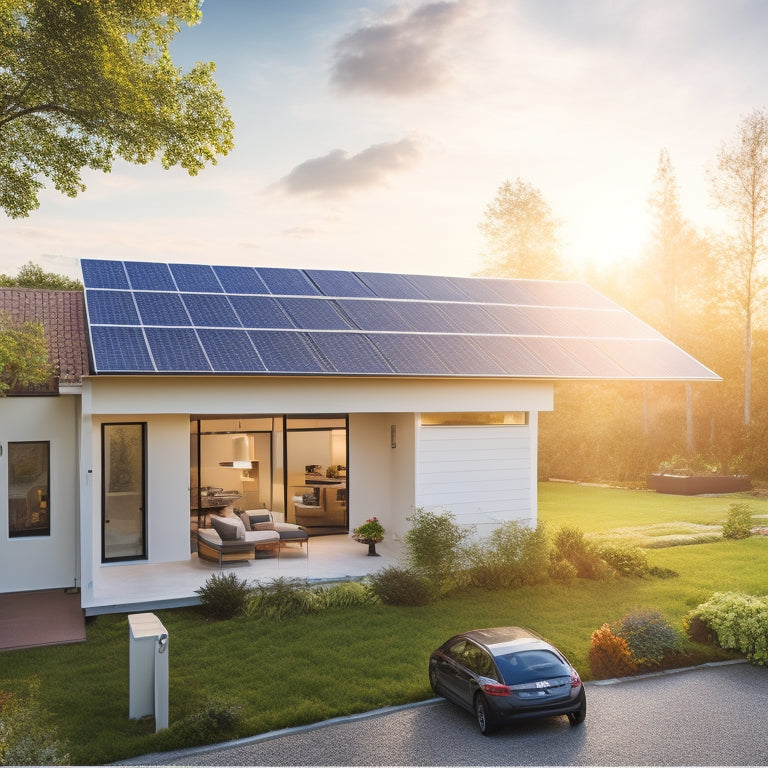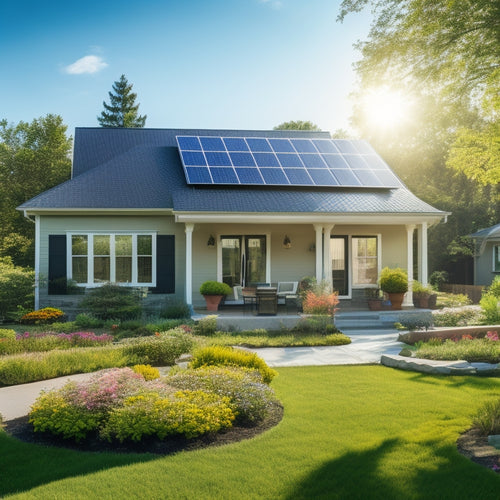
7 Essential Tips for Residential Solar Panel Systems
Share
To maximize your residential solar panel system's efficiency, evaluate your historical electricity consumption and conduct an energy audit to pinpoint peak usage. Choose high-efficiency, monocrystalline silicon panels for robust performance and longevity. Confirm that your roof's orientation, pitch, and shading are ideal for energy production, and verify its condition for long-term support. Check local zoning laws, permits, and incentives to streamline installation. Vet installation companies by validating their licenses, certifications, and past projects. Explore financing options like solar leases and PPAs. Continuously monitor system performance with advanced tracking. By following these steps, you'll guarantee your investment pays off. Learn more to get started.
Key Takeaways
- Assess Energy Needs and Roof Suitability: Conduct an energy audit and assess roof orientation, pitch, and shading for optimal solar panel placement.
- Choose High-Efficiency Panels: Select panels with high efficiency and low degradation rates to ensure long-term energy production and savings.
- Understand Local Regulations: Familiarize yourself with zoning laws, permits, and incentive programs to streamline the installation process and maximize financial benefits.
- Verify Installer Credentials: Ensure the installation company has NABCEP Certification, state licenses, and insurance to guarantee compliance and quality workmanship.
- Monitor System Performance: Utilize advanced monitoring systems to track energy output and system efficiency, ensuring optimal performance and timely maintenance.
Assess Your Energy Needs
https://www.youtube.com/watch?v=khYZTmm7S5I
To accurately determine the most suitable size of your residential solar panel system, begin by analyzing your historical electricity consumption data, typically found on your utility bills. This data provides a baseline for your energy audit, allowing you to dissect your usage patterns and pinpoint peak consumption periods. By understanding when and how much energy you use, you can tailor your solar system to meet your specific needs.
Conducting a thorough energy audit involves more than just looking at your bills. Examine your household's daily and seasonal energy usage to identify inefficiencies. Are there appliances running unnecessarily? Is your HVAC system working overtime during certain months? Addressing these issues can reduce your overall consumption, making your solar investment more efficient.
Furthermore, consider any future changes that might affect your energy needs. Are you planning to buy an electric vehicle or add more appliances? Factor these into your calculations to ensure your solar system can accommodate future growth.
Analyzing your usage patterns with precision allows you to design a solar solution that maximizes energy production and aligns with your lifestyle, ultimately granting you the freedom from rising energy costs and grid dependency.
Choose the Right Panels
When selecting the appropriate solar panels, prioritize efficiency and output ratings to guarantee peak energy production.
Evaluate the durability and warranty terms to secure long-term performance and investment protection.
Take into account the aesthetic and design elements to make sure the panels complement your home's architecture.
Efficiency and Output Ratings
Selecting the right solar panels hinges on understanding their efficiency ratings and output capacities, which directly impact your energy savings and system performance. Peak efficiency, typically expressed as a percentage, indicates how well a solar panel converts sunlight into usable electricity.
High-efficiency panels, often exceeding 20%, are ideal if your roof space is limited but you still want to maximize energy production. However, these high-efficiency panels may come at a premium cost.
Output degradation is another critical factor. All solar panels experience some level of performance decline over time, but the rate of degradation varies. Look for panels with lower annual degradation rates—typically around 0.5% per year. This guarantees that your panels will continue to produce a significant portion of their initial output even after decades of use.
Examine the manufacturer's data sheets for specific metrics like the power tolerance range and temperature coefficient. The power tolerance range indicates the accuracy of the panel's rated power output, while the temperature coefficient shows how well the panel performs under different temperature conditions.
Durability and Warranty
Evaluating the durability and warranty of solar panels guarantees that your investment withstands the test of time and adverse weather conditions. High material quality is important; panels made from monocrystalline silicon typically offer superior longevity and efficiency. Look for panels with robust framing, often made from anodized aluminum, which resists corrosion and physical damage.
Manufacturers usually provide two types of warranties: performance and product. Performance warranties make sure that your panels will produce a specified output level, often guaranteeing 80-90% efficiency after 25 years. Product warranties, on the other hand, cover defects and failures in materials and workmanship, typically lasting around 10-12 years but can extend up to 25 years with premium options. Opt for panels with longer warranties as they reflect the manufacturer's confidence in their durability.
Maintenance plans are another important consideration. Although solar panels require minimal upkeep, having a maintenance plan can save you from unexpected expenses related to cleaning, inspections, and minor repairs. Companies offering thorough maintenance plans often use higher-quality materials, ensuring fewer issues over the system's lifespan.
Aesthetic and Design
Choosing the right solar panels involves balancing both aesthetics and technical efficiency to complement your home's design while maximizing energy output. Panel aesthetics play an essential role in this balance. You want panels that not only perform well but also integrate seamlessly with your roof's architecture.
Design considerations should start with the type of solar cells. Monocrystalline panels offer a sleek, uniform look and boast high efficiency, but they come at a premium. Polycrystalline panels, while slightly less efficient, have a bluish hue and a more granular texture. Thin-film panels are less efficient but are highly flexible, which might suit unconventional roof designs.
Next, consider the color and frame of the panels. Black-on-black panels provide a modern, streamlined appearance, blending well with dark roofs. Silver-framed panels with blue cells, on the other hand, might clash with certain home designs but are often more budget-friendly.
Evaluate Roof Suitability
When evaluating your roof's suitability for solar panels, consider factors like orientation, pitch, and shading to guarantee maximum energy production. Start with roof orientation—solar panels perform optimally when facing true south in the northern hemisphere. An orientation deviation of up to 45 degrees east or west won't drastically impact efficiency, but precise alignment ensures peak performance.
Next, assess roof pitch. Ideal angles range between 30 to 45 degrees, aligning with the sun's trajectory to maximize energy absorption. A steeper pitch can lead to reduced efficiency, while a flatter roof may require additional mounting structures to achieve the best tilt.
Shading assessment is important. Even minor shading from trees, chimneys, or adjacent buildings can have a significant impact on energy production. Use tools like solar pathfinders or shade analysis software to map out potential obstructions throughout the year. Aim for a shading-free zone between 9 AM and 3 PM to harness the sun's power at its best.
Lastly, evaluate roof condition and material. Solar panels have a lifespan of 25-30 years, so make sure your roof can support them long-term. Asphalt shingles, metal, and tile are generally compatible, while wood and slate may require special considerations.
Check Local Regulations
After confirming your roof is suitable for solar panels, explore local regulations to navigate zoning laws, permitting processes, and incentive programs specific to your area. Zoning laws can vary dramatically, impacting installation height, placement, and even the type of solar technology permissible. Delve into the local municipal codes and consult your city's planning department to understand any spatial restrictions.
Permit requirements demand equal attention. You'll need to secure building permits, electrical permits, and sometimes special solar permits. This often involves submitting detailed plans, and undergoing inspections to ensure compliance with safety standards and building codes. According to a 2021 report by the National Renewable Energy Laboratory, the average permit approval process can take between 2 to 8 weeks, depending on where you live.
Don't overlook incentive programs. States like California and New York offer robust tax credits, rebates, and net metering policies which can significantly reduce your upfront costs. Use databases like DSIRE (Database of State Incentives for Renewables & Efficiency) to identify opportunities that can make your investment more affordable.
Research Installation Companies
When researching installation companies, you should verify their licenses and certifications to confirm compliance with industry standards.
Compare cost estimates from multiple providers to assess financial feasibility and potential ROI.
Additionally, evaluate their experience levels by reviewing past projects and customer testimonials to gauge workmanship quality.
Verify Licenses and Certifications
To guarantee a seamless and legally compliant installation of your solar panel system, it's imperative to verify that your chosen installation company holds the necessary licenses and certifications required by your state and local authorities. Certification standards and licensing requirements ensure that the company adheres to industry best practices and legal regulations, safeguarding your investment.
When evaluating potential installers, verify the following credentials:
-
NABCEP Certification: Ensures the installer meets North American Board of Certified Energy Practitioners (NABCEP) standards, the gold standard in solar installations.
-
State Electrical License: Confirms the installer's compliance with local electrical codes and safety regulations.
-
General Contractor's License: Indicates the company's authorization to perform construction work in your area.
-
Insurance Coverage: Protects you from liabilities during the installation process, including worker injuries and property damage.
-
Manufacturer Certifications: Validates that the installer is trained and approved by solar panel manufacturers to install their products.
Ensuring these credentials not only guarantees a higher quality installation but also liberates you from future legal and financial headaches. Compliance with certification standards and licensing requirements is non-negotiable. It's your pathway to a trouble-free shift to renewable energy, empowering you to harness the sun's power confidently and responsibly.
Compare Cost Estimates
Obtaining multiple cost estimates from various installation companies allows you to compare pricing structures, assess value, and make an informed decision that aligns with your budget and installation needs.
It's important to explore the specifics of each quote, examining the breakdown of costs to identify any hidden fees. Some companies might offer a lower upfront cost but introduce additional charges later, such as for permits or grid connection, which can inflate your total expenditure.
Maintenance costs are another vital factor to take into account. While some companies include a maintenance package in their initial estimate, others might charge separately for regular upkeep and potential repairs. Evaluating these elements upfront ensures that you're not caught off-guard by unexpected expenses down the line.
Additionally, request a detailed analysis of the projected energy savings and payback period for each proposal. This data-driven approach allows you to gauge the long-term financial benefits and ROI of your solar investment.
Comparing warranties on both equipment and installation services can also offer insights into the long-term reliability and cost-effectiveness of each provider. Armed with detailed cost estimates and a clear understanding of potential expenses, you'll be well-equipped to choose the best solar installation company for your needs.
Evaluate Experience Levels
Evaluating the experience levels of installation companies is crucial to guaranteeing a successful and efficient solar panel system installation. You need to explore the professional expertise and technical knowledge of the companies you're considering. Look for these key indicators:
-
Years in Business: A company with a decade or more of experience likely has the technical knowledge necessary to handle complex installations.
-
Certifications and Licenses: Confirm the company holds relevant certifications like NABCEP (North American Board of Certified Energy Practitioners) and state-specific licenses.
-
Completed Projects: Ask for a portfolio of past installations, especially ones that mirror your system's complexity and scale.
-
Customer Reviews and Testimonials: Seek out reviews on platforms like Better Business Bureau (BBB) or Google Reviews to gauge customer satisfaction and reliability.
-
Technical Support and Aftercare: A robust aftercare service indicates a company's commitment to long-term performance and customer satisfaction.
These elements combined will give you a clearer picture of the company's capabilities. Remember, choosing a company with the right mix of professional expertise and in-depth technical knowledge will free you from future hassles and ensure your solar panel system performs optimally for years to come.
Make informed choices to achieve that liberation from traditional energy constraints.
Understand Financing Options
Exploring through various financing options for residential solar panel systems can help you identify the most cost-effective solution tailored to your budget and energy needs.
First, consider loan types. Solar-specific loans, such as Home Equity Loans (HELOCs) and Property Assessed Clean Energy (PACE) loans, offer competitive interest rates and flexible terms. HELOCs allow you to borrow against your home equity, while PACE loans are repaid through property tax assessments. Both options can provide you with the capital needed for installation without depleting your savings.
Leasing options, like solar leases and Power Purchase Agreements (PPAs), provide an alternative if upfront costs are a concern. Under a solar lease, you pay a fixed monthly fee to use the solar panels, while the installer remains the system owner. With PPAs, you pay for the electricity generated by the panels at a predetermined rate, often lower than your utility's rate. Both options typically include maintenance and monitoring services, reducing your long-term costs.
Evaluating these options requires a thorough cost-benefit analysis. Calculate the total cost over the system's lifespan and compare it to potential savings on your energy bills. This strategic approach helps you maximize your financial and environmental benefits.
Monitor System Performance
Once you've secured the best financing for your residential solar panel system, it's essential to monitor system performance meticulously to confirm you're achieving the expected energy output and savings. Real-time monitoring and performance tracking are vital for guaranteeing your investment delivers the promised returns.
Leverage advanced monitoring systems that provide instantaneous data on various performance metrics. This empowers you to act promptly if inefficiencies or malfunctions arise.
Here are essential components to ponder for effective performance tracking:
-
Energy Output: Track the kilowatt-hours (kWh) your system generates daily, weekly, and monthly.
-
System Efficiency: Monitor the conversion efficiency of your solar panels to ensure they operate within the expected range.
-
Inverter Performance: Keep an eye on inverter efficiency, as it's critical for converting generated DC power into usable AC power.
-
Weather Impact: Analyze how local weather conditions affect your system's performance to optimize energy usage strategically.
-
Alert Systems: Set up automated alerts to notify you of any anomalies or performance drops in real-time.
Frequently Asked Questions
How Long Do Solar Panels Typically Last Before Needing Replacement?
You won't believe it, but solar panels can last up to 30 years before needing replacement! With stellar warranty periods and minimal degradation rates, they're a reliable, liberating investment for long-term energy independence.
What Maintenance Is Required for Solar Panels?
You should clean your solar panels biannually to guarantee maximum efficiency. Schedule technician inspections annually to identify potential issues early. Keeping up with this maintenance liberates you from unexpected power losses and costly repairs.
Can Solar Panels Work During Cloudy or Rainy Days?
Don't worry if it's cloudy or rainy; solar panels can still generate energy. While energy output and panel efficiency might drop, modern technology guarantees they still produce electricity, albeit at reduced capacity, liberating you from grid dependency.
Are There Any Tax Incentives or Rebates for Installing Solar Panels?
Yes, you'll find Federal incentives like the Investment Tax Credit (ITC) reducing costs by 26%. State rebates vary, offering additional savings. Check your local regulations for precise data, liberating your energy bills and boosting sustainability.
How Do Solar Panels Impact the Resale Value of a Home?
Solar panels can greatly enhance your home's resale value. They offer energy savings and increase property appeal. Studies show homes with solar systems sell for 4.1% more. Buyers love the long-term benefits and eco-friendly advantage.
Related Posts
-
Trends in Renewable Energy Storage Technologies
You're witnessing rapid advancements in renewable energy storage technologies aimed at improving efficiency and scala...
-

Energy-Efficient Heating and Cooling Appliances
Energy-efficient heating and cooling appliances can cut your energy bills markedly. By opting for models with high En...
-

Affordable Solar Panels for Home Use
Affordable solar panels offer you a smart way to cut down on energy costs while promoting sustainability. With govern...

